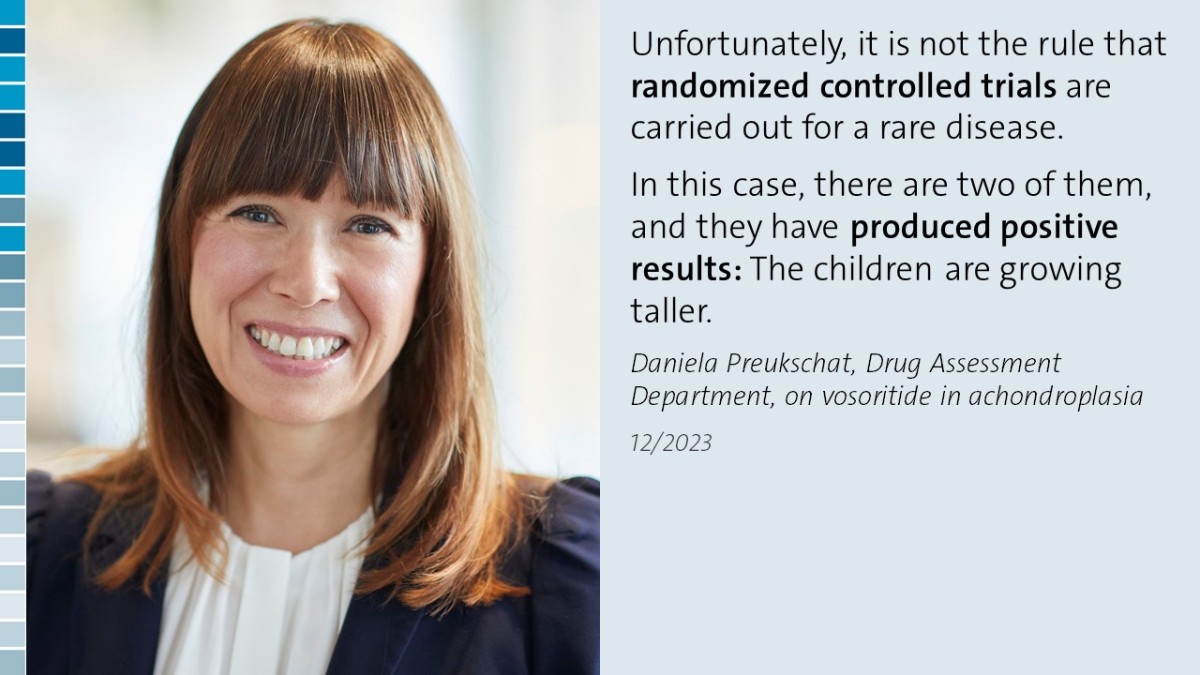Dec 1, 2023
Vosoritide for achondroplasia: indication of added benefit for children aged two years and older
Two small RCTs with children of different ages allow a joint conclusion: The new drug promotes length growth.
Two small RCTs with children of different ages allow a joint conclusion: The new drug promotes length growth.
In an early benefit assessment, the Institute for Quality and Efficiency in Health Care (IQWiG) investigated whether vosoritide offers an added benefit compared with the appropriate comparator therapy (ACT) best supportive care (BSC) for patients two years of age and older whose epiphyses are not closed.
The (German-language) report was published in December 2023; an English translation in March 2024.
Conclusion: There is an indication of a non-quantifiable added benefit because children treated with the drug grow more than those without this treatment. However, it is still unclear what height they will ultimately reach and to what extent the increased growth will prevent the late complications and functional impairments associated with the disease.
Drug delays premature ossification of the epiphyses
Achondroplasia is the most common form of genetic short stature and is associated with shortened limbs, back pain and chronic infections, among other things. This is caused by premature ossification of the epiphyses, i.e. the cartilaginous growth zones at the ends of long bones. Without treatment, people with achondroplasia usually reach a height of 120 to 135 centimetres. Until now, there has been no drug treatment tailored to this rare disease; growth hormones, for example, do not work in achondroplasia.
Now vosoritide has been approved, a drug that stimulates the proliferation of cartilage cells and thus stops the premature ossification of the epiphyses. Treatment is continued until the epiphyses are closed, i.e. growth is completed.
The children grow taller
There are data from two small RCTs comparing vosoritide treatment in addition to BSC with BSC alone over 52 weeks. The drug manufacturer presented additional long-term data from single-arm studies.
Despite the small groups, the meta-analysis showed a significant difference in the key outcome of height. At the age of 2 to under 5 years, the average growth in 52 weeks was 6.38 cm under vosoritide treatment, and 5.41 cm in the comparator arm (difference: 0.96 cm). The older children grew an average of 5.86 cm per year in the intervention arm and 4.29 cm in the comparator arm (difference: 1.57 cm). The supporting analyses of the long-term data show that the growth continues and adds up over the years.
No conclusions can currently be drawn for a period longer than seven years because there is still too little data available for the later time points of recording. “It is therefore not yet possible to estimate exactly how tall the patients will ultimately be,” explains Daniela Preukschat, who is responsible for chronic diseases in IQWiG’s Drug Assessment Department. In addition, it is still unknown to what extent the increased growth can prevent the late complications and functional impairments associated with the disease. Therefore, the conclusion is: indication of a non-quantifiable added benefit of vosoritide plus BSC compared with BSC alone.
However, there are signs that many of those affected can reach a height of between 140 cm and 150 cm. This would make them small in stature according to the usual definitions, but not severely disabled. “Unfortunately, it is not the rule that RCTs are carried out for a rare disease,” adds Preukschat. “In this case, there are two of them, and they have produced positive results.”
G-BA decides on the extent of added benefit
The dossier assessment is part of the early benefit assessment according to the Act on the Reform of the Market for Medicinal Products (AMNOG) supervised by the Federal Joint Committee (G-BA). After publication of the dossier assessment, the G-BA conducts a commenting procedure and makes a final decision on the extent of the added benefit.
You can find an overview of the results of IQWiG’s benefit assessment in an English extract. In addition, the website informedhealth.org published by IQWiG provides easily understandable information on this benefit assessment.


